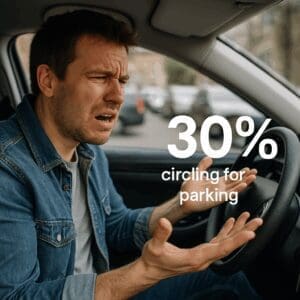Parking control and equitable access to parking have been an urban challenge since the proliferation of the automobile in modern life. We gave up stables and detritus in the streets and gained better mobility, traffic jams, new safety concerns, and urban sprawl. Cities and Universities have similar but unique considerations for their citizens and students to have access to businesses, residences, and classrooms. Since the first parking meter was installed in Oklahoma City in 1935, agencies have been faced with the challenge of enforcement, collections, and associated services.
Today’s parking solutions have come a long way since the simple meter and citation model of the past and include many technology options. Many of these are cutting-edge and upend traditional models in favor of virtual solutions where the customer pays from the mobile device and enforcement occurs via license-plate recognition.
Today’s parking enforcement considerations are complex and more varied than ever before.
Consider the options that exist for even a medium-sized municipality or university. The entire topology of such an entity could include the following:
- A “Prime” Zone of Street Parking for Downtown Businesses and Office Spaces
- Municipal permit lots and parking structures where parking is done by permit
- An “intermediate” zone of mixed permit parking and metered spaces
- An “outlying” zone of free public parking space with control requirements like no overnight parking
- Entertainment venues that have event-based parking control requirements.
- University event parking that is standard parking during non-event times.
This is one example of the sort of mixed requirements that most modern enforcement solutions can handle. It can, of course, be even more complex and granular than that. Let’s look at how this can affect the investment in enforcement.
Calculating Payback
When considering a parking enforcement solution, it’s important to consider the payback period – how long it will take for the system to pay for itself. There are a number of factors to consider, including the initial investment, ongoing costs, revenue, and more subjective factors.
Initial investment – Understanding what is upfront.
Whether this is your first automated system moving from written tickets to automated citations or you are upgrading your current system, estimating the cost of the investment over the expected deployment lifetime is important. Software licensing, hardware costs, accessories, installation, and are one set of expenses that are fixed. However, it is also important to understand the variable costs such as software upgrades, consumables, system maintenance, training, minor upgrades, cloud-hosting, and wear and tear costs. There also could be charges for third-party services such as DMV lookup services. Together these costs factor into the return on the investment or break-even period.
Citations – Only part of the picture
Enforcement activities are only a part of the overall picture of a city or university’s parking enterprise, the full scope of which is too complex for this article. Still, enforcement strategy has to be an integral part of the overall plan.
Historically, citations, popular or not, are often a significant revenue source. As citations must have a deterrent effect, the revenue can add up quickly. Universities tend to get most of their parking revenue not from enforcement but from the sale of permits, meter collections, and parking fees for events.
Larger cities generate more revenue, but when you look at the revenue generated per capita, there are variances. Santa Fe, New Mexico, with a population of approximately 83,000, created $421,300 in revenue or, $5.05 per citizen, according to this post, while Nashville, Tennessee, with a population of nearly 691,000 received revenue of $600,000 or less than a dollar per citizen.
It is generally accepted that the average city will spend between $0.50 to $1.50 per citizen on enforcement costs, so in those instances, Santa Fe should be profitable, while Nashville may be struggling to break even. These variances are based on policies and other factors, such as the size of business districts.
During the core of the pandemic years of 2020-2021, parking revenues in the form of permits, fees, and citations took a major downturn as people stayed at home and more people worked remotely. The City of Seattle, for example, generates about ⅓ of its budget from parking activities, so the shortfalls were significant.
Citation Issuance
Using the example of issuing 75 citations per month (just over two a day) at an average citation cost, it is easy to see why vendors of parking enforcement solutions quote break-even times of little more than 12 to 18 months.
Permit Management
The other area where parking solutions can really add to their usefulness is permit management. Whether permits are verified by sticker, mirror tag, pay by phone services, or by license plate recognition (virtual permits), efficient and speedy assessment of permits are an important part of a school or city’s enforcement activities.
Modern parking enforcement solutions allow for many types of permits and variances within the parking enterprise, so permit programs must be more granular to meet public needs. For instance, the same entity could conduct lookups of city permits, lot permits, student permits, and RV licenses.
The less tangible but every bit as real
Efficient parking enforcement leads to better customer satisfaction when viewed on the whole. Parking enforcement is critical for local businesses, services, and education access. Parking enforcement can lead to a higher rate of turnover in parking spots which also increases parking revenue and access for customers. Cities and schools that supply the latest conveniences in parking technologies, such as payment via an app, virtual permit, license-plate recognition, and e-citations, can realize both the benefits of more revenue and better customer satisfaction.
The Cardinal Tracking sales team can help you understand how quickly an investment in your enforcement solution as either a new acquisition or upgrade of your existing system can pay for itself. You will likely be surprised at how fast.




